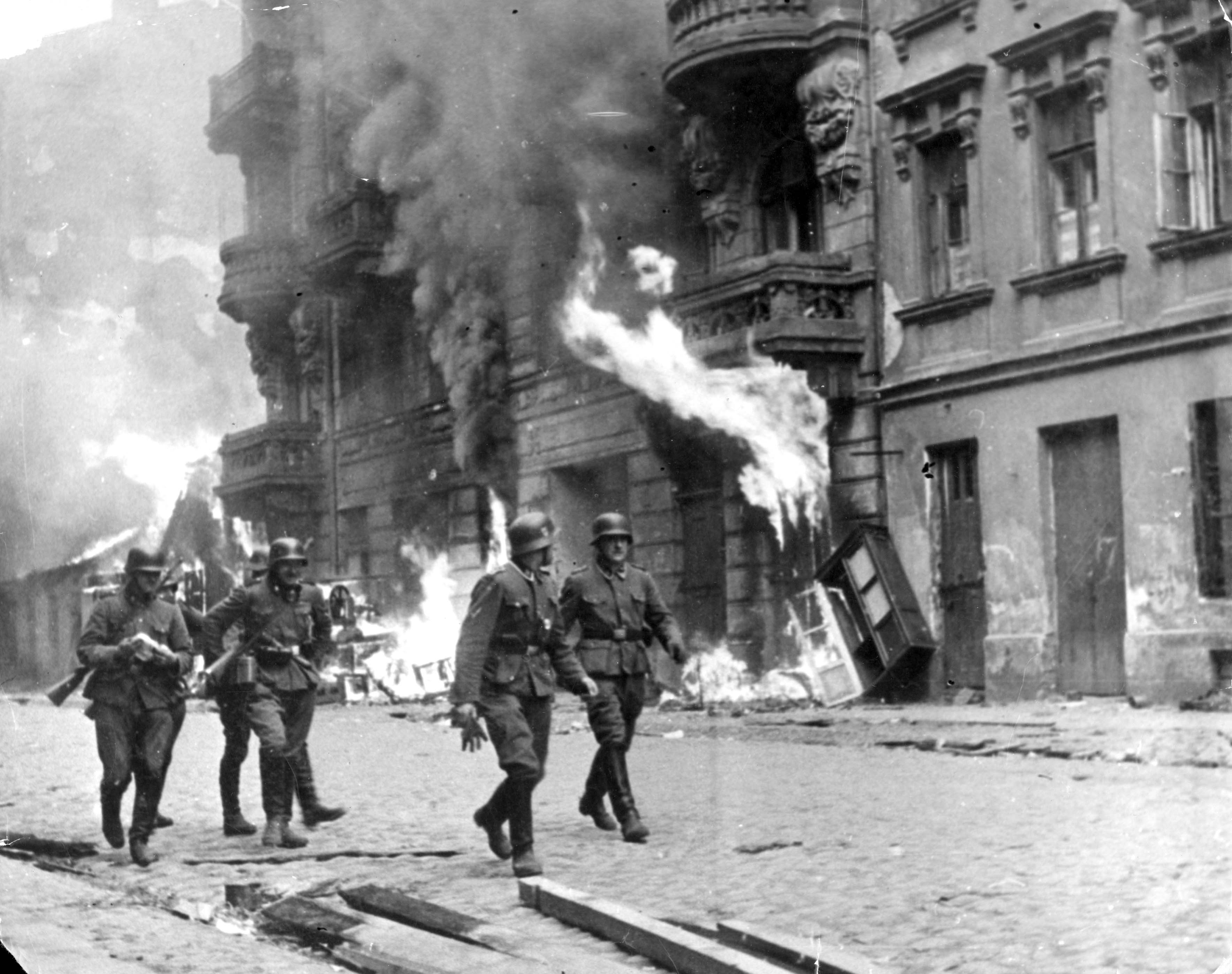
Warsaw, Poland, 1943, General Stroop's men next to burning buildings during the suppression of the uprising
Seventy years ago, on January 18, 1943, in the Warsaw Ghetto, a group of Jews attacked German forces who were rounding up Jews for deportation to the extermination camps. Although nearly all the Jewish attackers were killed in the ensuing fight, the experience gave hope to the Jews in the ghetto and prepared the groundwork for the Warsaw Ghetto Uprising in April.
Here's a piece by Dr. Robert Rozett, Director of the Yad Vashem Libraries, about the significance of this little known battle. The piece originally ran in the Jerusalem Post on January 17, 2013.
The Little Known Uprising – Warsaw Ghetto January 1943
In January 1943 there were only 60,000 Jews left in the Warsaw Ghetto. They were what remained of the approximately 440,000 Jews who had been confined there. One-fifth had died of disease and starvation during the past two years, and the previous summer some 265,000 had been deported to the Treblinka extermination camp, and over 30,000 to other camps. At the start of the great deportation, the head of the Jewish Council, Adam Czerniakow had committed suicide rather than comply with German demands to provide census information about the ghetto, realizing the Germans would use it for the coming Aktion. His death, however, did nothing to stop the trains from rolling out of Warsaw. With Czerniakow dead and in wake of the deportations, a new de facto leadership emerged in the ghetto – the Jewish Fighting Organization, the ZOB, headed by Mordecai Anielewicz. The ZOB was a coalition primarily of various Zionist youth movements and the Jewish socialist Bund. Alongside it there was a smaller armed underground group, the Jewish Military Union, the ZZW, which represented the Revisionist Zionists.
On Monday, January 18, 1943, seventy years ago, German forces entered the ghetto to round up Jews for transport. They planned to take about 8,000 people, but the ghetto population believed the final destruction of the ghetto was at hand. To the great surprise of the German forces, they met armed resistance.
A group of Hashomer Hatsair members, led by Anielewicz and armed with pistols they had received from the Polish Home Army (AK), intercepted a column of Jews being led by a German force and fired upon the solders. In a nose-to-nose battle, most of the underground contingent was killed, but Anielewicz managed to overpower the soldier with whom he was struggling and he escaped unharmed. The news of the clash spread quickly to other cells of the underground and they too began to resist. Yitzhak Zuckerman, with a party from the Dror youth movement, lay in wait for the German force on Zamenhof Street, and when they approached fired a volley at them.
During four days the Germans tried to round up Jews and were met by armed resistance. The ghetto inhabitants went through a swift change. With the news of the first incident of fighting they stopped responding to the Germans’ calls that they gather in the Umschlagplatz. They began devising hiding places, and the Germans had to enter many buildings and ruthlessly pull out Jews. Many were killed in their homes when they refused to be taken. On the fourth day, having only managed to seize between five and six thousand Jews, the Germans withdrew from the ghetto. The remaining inhabitants believed that the armed resistance combined with the difficulties in finding Jews in hiding, had led to the end of the Aktion. As a result, over the next months the armed undergrounds sought to strengthen themselves and the vast majority of ghetto residents zealously built more and better bunkers in which to hide.
All of this would be put to the test on April 19, 1943 when the Germans reentered the ghetto, this time to liquidate it completely. Again they met armed resistance. The fighting would continue for three weeks before the ghetto was razed, and it would come to be known as the Warsaw Ghetto Uprising.
The four days of Jewish armed resistance in the Warsaw Ghetto in January 1943 is much less known than the April uprising, but its significance was great at the time and remains consequential. At the time it showed the Jews of Warsaw that offering resistance to the German machinery of murder was possible, even if most realized that fighting had little or no chance to bring salvation. Nonetheless, this first uprising provided a glimmer of hope, and was an enormous source of pride, tremendously important to people who had been profoundly traumatized by preceding events and had a good idea what was in the offing for them.
Ultimately only a small percentage of Jews survived the Warsaw Ghetto and deportations to the Nazi camp system. We would be hard pressed to say they survived directly because of the armed resistance in the ghetto, but unquestionably, that resistance was crucial in helping the few survivors maintain their pride, dignity, and motivation to survive, and ultimately rebuild their shattered lives.
The January 1943 Warsaw Ghetto Uprising teaches us a great deal about the human spirit, about resilience, and about courage. It demonstrates that the very act of resistance against oppression can inspire further resistance. In taking up arms against those who considered them less than human, the men and women on January 18, 1943 in the Warsaw Ghetto issued a resounding, clarion call asserting their humanity. It is this, above all, that we must remember and hold dear.










